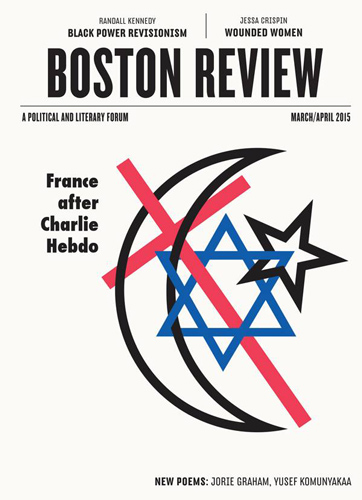Boston Review – March/April 2015
Boston Review: A Political and Literary Forum, which publishes six issues per year, recentlycelebrated its fortieth anniversary, and that level of time and experience is evidenced by the high quality of the writing and the magazine’s simple yet elegant design. Aesthetically, I enjoyed how the poems were contained within thinly outlined boxes, the dimensions of which changed to best suit the need of each individual piece. Boston Review: A Political and Literary Forum, which publishes six issues per year, recentlycelebrated its fortieth anniversary, and that level of time and experience is evidenced by the high quality of the writing and the magazine’s simple yet elegant design. Aesthetically, I enjoyed how the poems were contained within thinly outlined boxes, the dimensions of which changed to best suit the need of each individual piece.
Comparisons between the Boston Review and the New Yorker are unavoidable; both come in magazine format and share a common vision, in terms of content and overall design. Boston Review distinguishes itself, however, in two distinct ways: first, the majority of the nonfiction pieces I read in the March/April 2015issue were more journalistic in nature than those typically found in the New Yorker, which is to say that the writer was largely absent from the narrative, and second, because Boston Review only produces six issues a year, this affords the editorial staff the time and opportunity to foster discussion among experts on a given topic, as in the recurring department, “New Democracy Forum.” In the March/April issue, the subject was “France After Charlie Hebdo.” The initial article, written by professor of anthropology at Washington University in St. Louis, John R. Bowen, is followed up by nine different experts—ranging from professors to editors to authors—weighing in on Bowen’s piece. Finally, Bowen is given a chance to respond to those responses. On BR’s website, the “About” page reads as follows: A flourishing democracy depends on engaged public discussion of ideas that matter. “New Democracy Forum,” most clearly exemplifies this intention.
In a section titled “Private Life,” the writer J. A. Bernstein talks about his experiences as an American voluntarily serving in the Israeli Armed Forces. It’s a fascinating essay, filled with arresting descriptions of the town in which Bernstein was stationed.
“Poet’s Sampler” is a regular department that features a number of the poet’s pieces. Hoa Nguyen, a professor at Ryerson University, briefly introduces us to the work of poet Damian Rogers: “Rogers’s poems are ominously beautiful and sage; they lay bare discordant fractures.” Of the five poems, the fourth, “The Warlock’s Forelock,” was by far my favorite. In twenty-one couplets, Rogers explores such subjects as her younger self’s love of steel drums, her childhood in Ottawa, her current motherhood, the wildness of her early twenties, and thoughts on being a pet owner, all of which lead to a satisfying—and emotionally resonant—final moment:
One guy saw light shoot out of my head.
Tonight, I tune the rain. Our least-favoritecat trapped in the worst of it. I felt
love as we rescued him from his tinyterror. Once he was safe I lost interest.
I cried this afternoon. It’s my new thing.
Like the New Yorker, each issue of the Boston Review includes only one work of fiction. “At the Birthplace of Sound,” by Akil Kumarasamy, is the author’s first published work. The story is written in the second person—a convention that I typically find off-putting. But here, Kumarasamy pulls off a nifty trick; she invites you into the main character Karna’s headspace while also managing to move the narrative forward. It is expertly done.
Although similar to the New Yorker, Boston Review really sets itself apart with their fortieth issue, showcasing well-executed writing in all its offered genres.
[www.bostonreview.net]





